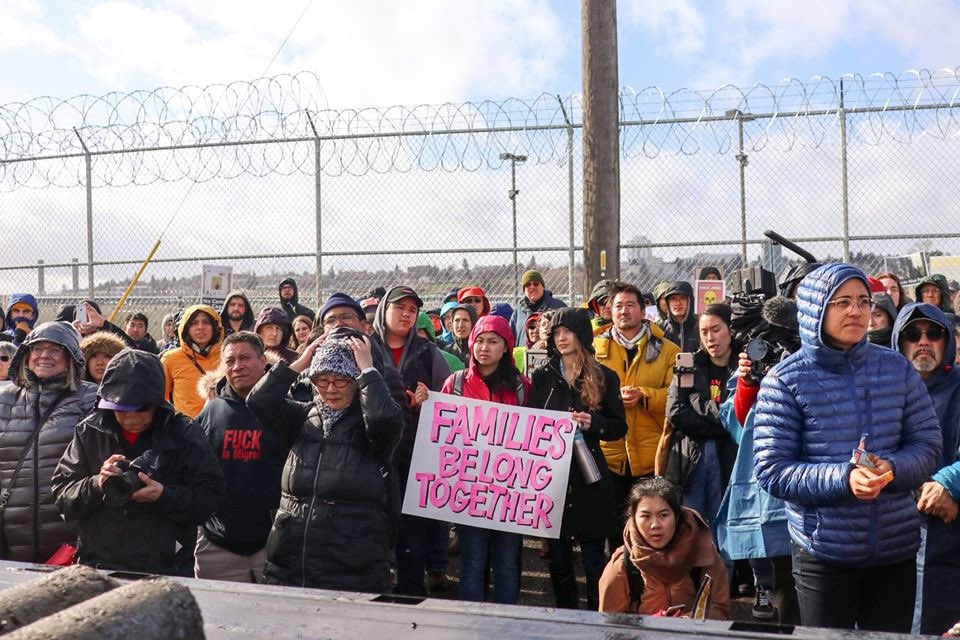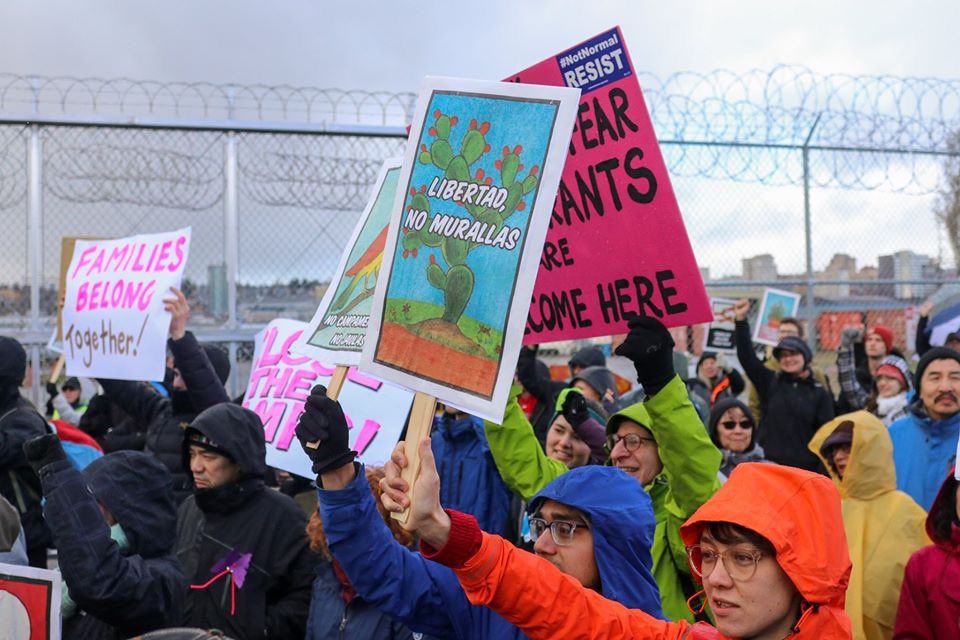What can birds teach us about movement/s?
Last weekend, Global Big Day took place, a birding event for people from around the world to come together to count and identify local birds. I found out about this from a bird ID app, which is both amazing and convenient to have on my phone. It’s essentially a Pokédex for birds (akin to a dichotomous key.) I now have a small bird repertoire which I can sight and listen to from my window. This has most often been a stellar’s jay lately, a beautiful blue-feathered bird who is, frankly, noisy af.
(Fun fact: Stellar’s Jay is the provincial bird of BC, in case you didn’t know!)
This spring, I created a bird-inspired collage for a mail art exchange with United Aunties.
This project, led by Clare Yow and Leo Yu, invited participants from the Lower Mainland to create a piece of mail art, either a call or a response to another work. The theme was imagining new worlds or eras.
I was assigned to create a response to another piece mailed to me. The mail art I received included a polaroid print, its photo cut out and filled with shiny metal cells, captioned THIS IS OUR NEW HOME NOW. I later found out this piece had been created by local photographer WY. (You might see above, I tried to expand those cells in my piece with the imagery of honeycomb.)
WY’s piece mostly made me think of confinement and the pandemic’s stay home orders. But I also thought about cages and the last time I crossed the U.S. border. I drove down to Washington state to attend a rally for Japanese American (JA) Day of Remembrance and Day of Action.
Every February, Japanese American Day of Remembrance recognizes JA internment history on the day that US President Franklin Roosevelt signed Executive Order 9066 in 1942, leading to the incarceration of 120,000+ people from the JA community.
In recent years, progressive JA orgs have shifted this Day of Remembrance to a Day of Action, using their platforms to bring attention to related issues of racial injustice, such as the treatment of Muslims and Arab Americans after 9/11 and Trump’s border policies.
The rally took place at the Northwest Detention Centre in Tacoma, WA on Duwamish territories. NWDC is the largest privately-run ICE detention centre on the west coast. By “privately-run,” I mean to say that yes, they actually profit off the incarceration of human beings. 🤮
#ShutDownNWDC @ResistenciaNW @DenshoProject 
[You can see blue sky in this photo above, but as you can tell from everyone’s clothing, it was a chilly day. I remember a LOT of wind… made it hard to hold up the glittery gold crane poster I had made for this rally.]
When I arrived at the ICE facility, its barbed wire fence was strung with hundreds of colourful hand-folded paper cranes. (Because of the weather, they were actually covered in clear plastic bags meant for wet umbrellas.) These cranes were folded by volunteers with nonviolent direct action project, Tsuru for Solidarity, made up of “Japanese American social justice advocates and allies working to end detention sites and support directly impacted immigrant and refugee communities that are being targeted by racist, inhumane immigration policies.“
“Tsuru” translates to “crane” in Japanese.

“We bring tsuru to protest sites as a sign of peace and healing.”
—Tsuru for Solidarity
On a small stage, stories were shared from former migrant detainees and a poet performed for a captive audience. As chains of paper cranes blustered in the wind, musician Kishi Bashi played a swelling violin. La Resistencia NW organizers led us in chants of "Chinga la migra!" instructing us to chant as loudly as we could, so people on the inside could hear our messages of support, care, and resistance.
At one point, an organizer was able to make a call to a migrant detainee on the inside. Hooked up to an amplified speaker, this person spoke to us over the phone, sharing details about the awful and dehumanizing conditions they faced on the daily.
Near the end of the event, Japanese American internee survivors and their descendants carried out a remembrance ceremony. Then, organizers and activists delivered a letter to the warden with demands to end deportations and shut down NWDC.
Side note: I realize this may have taken a darker turn that you expected, from the initial mention of birds and now to immigrant detention and human rights violations, but alas, this is sorta how my brain works sometimes? I swear, I’m not all doom and gloom though! 🤡
(Another fun fact, I was truly terrified of clowns as a child. I would literally run away from them.)
seeking a better life is not a crime. lack of "status" ≠ inhumane conditions, family separation and deportation. 
After the rally ended, a group of us who had driven down from Vancouver shared snacks and tea, in the way people used to gather together. (None of this is really at all the same via zoom… Sigh)
I wrote a haiku about the flowering plum tree outside the Air BnB where I slept overnight with two friends in my road trip crew. We ate Vietnamese take out for dinner. We visited a thrift store called Scorpio Rising. We pulled out our Canadian passports and crossed the border together, one last time.
These days, I can’t ponder movement—the freedom to come and go as one pleases—without thinking about systems of power and the world at large.
Borders. Cages. Displacement. Some of us have many more choices than others in the matters of where we travel or where we can live. Sometimes, this is on account of how one’s movement and presence may be policed more than others or heavily monitored in particular neighbourhoods. (These linked examples point to anti-poverty, anti-sex work, anti-drug use, anti-Indigenity and anti-Blackness, but there are many other reasons, too.)
In relation to ancestral homelands, some of us cannot go back to where we once came from, no matter how much we might dream about it.
In her mock “Lonely Planet, Palestine” design (above), artist Mona Chalabi writes:
Travellers should be aware that if you’re Palestinian, you don’t have freedom of movement. At these checkpoints, Israeli army officials control Palestinian’s right to move. Officers subject Palestinians to threats, verbal abuse, and sometimes violence.
Don’t worry though. If you’re a tourist you can move more freely than a Palestinian family that has lived here for over a century.
The violence happening in occupied Palestine is all over my social media feeds this week, perhaps yours, too. As is the news of protest in Colombia, the mass funerals and oxygen shortages in India, ongoing violence against the Asian diaspora—I could go on and on about the amount of pain and heartache in the world right now.
Truthfully, there’s part of me that wonders if I should broach the topic of Palestinian genocide at all, but the other part of me is thinking a lot about this and what I can do within my power. I created this space as a landing place for process, so I am willing to accept risk of critique. This is part of the learning.
I’m not an expert in any way about what is happening. However, when considering Palestine and the Nakba, the Israeli airstrikes and decades of war crimes, I know that the topic of borders is necessary to address and acknowledge. Borders as cages. Borders as political tools wielded for control. Borders normalized in settler-colonial states like Israel, like Canada.
This past winter, I found myself deeply immersed in the writings of author Arundhati Roy. In a speech she once delivered, titled “Come September,” she speaks to the war on terror, as fuelled by 9/11. Roy links “Anti-American”-isms with a critique of U.S. foreign policy, referencing the ethnic cleansing by the Israeli state in occupied Palestine—as per support from the US and as first enabled by tactics used against Indigenous people across the US and Australia.
“…the bloodshed doesn’t end. Palestine still remains illegally occupied. Its people live in inhuman conditions, in virtual Bantustans, where they are subjected to collective punishments, twenty-four hour curfews, where they are humiliated and brutalized on a daily basis. They never know when their homes will be demolished, when their children will be shot, when their precious trees will be cut, when their roads will be closed, when they will be allowed to walk down to the market to buy food and medicine. And when they will not.“
—Arundhati Roy in “Come September”
Roy delivered “Come September” in 2002 and it’s still relevant, nearly 20 years later.
I once read somewhere (perhaps also in the writings of Arundhati Roy—her book War Talk, perhaps?) about the environmental devastation that lingers long after the end of a war, most specifically after bombings. I’m not sure why reading about this surprised me, but I guess it just wasn’t something I had given much thought to before. Like I said, there is a lot I am still learning. I’ve never had to live through war.
The writing I read addressed the amount of time it takes for plant life to grow back on the land, for animal species to return, for whole ecosystems to rejuvenate. It’s not just people who are bombed upon, displaced, forced to become landless—whole homes and communities destroyed.
I imagine birds are there, too, witnessing the plight of Palestine.
Singing. Crying. Dying.
Flying away.
Where I live, birds are currently nesting. (Typically March through August in BC.) Wherever you are, I invite you to pay attention to what you see. You might observe birds building homes in trees. On the ground. Atop light fixtures on the side of a vacant building. Or even in the path of the Trans Mountain pipeline. Many of them have had to survive a very difficult migration, in order to build these homes, stick by stick.
What do you think birds can teach us about our movement/s? About making, building, or finding a home?
“We Will Not Be Erased” — by-donation event on Friday, May 14
To learn directly from affected Palestinians, join Mohammad El-Kurd, Majd Kayyal, Sandra Tamari, and Sumaya Awad as they unpack the history and ongoing reality of the Nakba.
💻 Find out more and register here. Free/by donation, hosted by Haymarket Books.
++ more on birds and writing
For a stunning story, I recommend Hsien Chong Tan’s “The Last Snow Globe Repairman In the World.” It first appeared in PRISM magazine and is also published in the Journey Prize (#32) anthology.🏅
In case you missed it, Hiromi Goto’s poem “alley/bird/ally” was shortlisted for the CBC poetry prize last year. I ❤️ the anarchist crows.
I can’t not mention Kyo Maclear’s memoir Birds Art Life. 🦆
And lastly, here is a bird comic by me.
These days, I’m reading… Burning Province by Michael Prior (poetry), Madness, Rack, and Honey by Mary Rufle (collected lectures), and Chiru Sakura: A Mother & Daughter’s Journey through Racism, Internment and Oppression by Grace Eiko Thomson (memoir)
I’m listening to… Feeling Asian by comedians Youngmi Mayer and Brian Park (podcast)
If you know any emerging youth artists, I will be supporting and leading a workshop in a free online arts program put on by Vines Festival this summer. Emerging Creatives is accepting applications until May 26, 2021.










